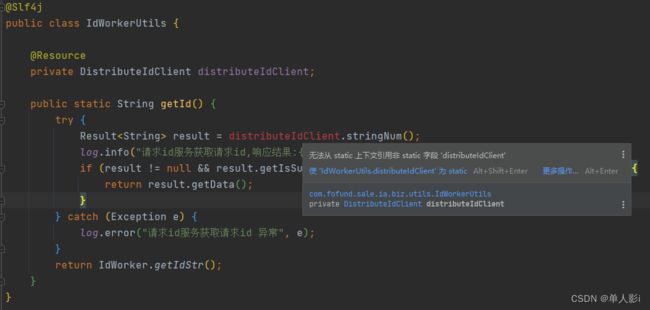- Vue——Vue-cli脚手架+前端路由
pdsu_zhao
VueVue学习之旅vuev-routerv-resourcevue-cliES6
Vue-cli是Vue的脚手架工具可以进行目录结构、本地调试、代码部署、热加载、单元测试1、MVVM框架View——ViewModel——Model(视图)(通讯)(数据)“DOM”“观察者vue实例”“Javascript”注意:交互为双向的特点:(1)针对具有复杂交互逻辑的前端应用;(2)提供基础的架构抽象;(3)通过Ajax数据持久化,保证前端用户体验。2、什么是Vue.js它是一个轻量级M
- AsyncHttpClient使用说明书
有梦想的攻城狮
netty学习专栏Javaasynchttpclient异步处理netty
[[toc]]AsyncHttpClient(AHC)是一个高性能、异步的HTTP客户端库,广泛用于Java和Scala应用中,特别适合处理高并发、非阻塞的HTTP请求。它基于Netty或Java原生的异步HTTP客户端实现,支持HTTP/1.1和HTTP/2协议,适用于微服务、API调用、爬虫等场景。1.核心特性特性说明异步非阻塞基于事件驱动模型,避免线程阻塞,支持高并发(如每秒数千请求)。HT
- Java的包结构
MingDong523
笔记
Java的包结构类就相当于文件夹(目录)。包结构的作用一般有以下两个方面第一个就是Java的包是根据Java文件的功能和性质来区分,方便区分和查找另一个就是重复的文件名可以存在于不同的包(文件夹)里。当我们选择去创建Java包时有两种创建方式,其中一种就是手动创建,手动创建包太过繁琐,不推荐。而另一种就是使用代码去创建(打包语句package),当我们使用打包语句时要注意一下几点1.在写packa
- Java中String类型的20个方法
MingDong523
笔记
根据长度来使用的方法:返回类型:int方法签名:String.length()作用:用来计算String中字符的个数根据数组来使用的方法:返回类型:byte类型的数组byte[]方法签名:String.getBytes()作用:将String类型转换成byte类型的数组返回类型:char类型的数组char[]方法签名:String.toCharArray()作用:将String类型转变成char类
- RestTemplate和RPC区别
酷爱码
经验分享rpc网络协议网络
RestTemplate是Spring框架中用于进行RESTful风格的HTTP请求的模板类,通常用于与外部服务进行通信。它基于HTTP协议,使用GET、POST、PUT、DELETE等HTTP方法来进行通信,传输的数据通常使用JSON或XML格式。它是一种基于资源的通信方式,通过URL来标识资源。RPC(RemoteProcedureCall)是一种远程过程调用的通信机制,用于不同进程或不同主机
- 深入浅出:序列化与反序列化的全面解析
进击的小白菜
一些开发常识开发语言开发常识
文章目录1.引言2.什么是序列化?2.1为什么需要序列化?3.什么是反序列化?3.1反序列化的重要性4.序列化与反序列化的实现4.1JSON(JavaScriptObjectNotation)4.2XML(eXtensibleMarkupLanguage)4.3ProtocolBuffers(Protobuf)4.4MessagePack5.安全性考虑6.性能优化7.结论附录:常见问题解答Q1:什
- Java高频面试之集合-13
牛马baby
面试职场和发展java哈希算法HashMap
hello啊,各位观众姥爷们!!!本baby今天来报道了!哈哈哈哈哈嗝面试官:为什么hash函数能降哈希碰撞?哈希函数通过以下核心机制有效降低碰撞概率,确保不同输入尽可能映射到不同的哈希值:一、设计原理与数学基础均匀分布(UniformDistribution)目标:使任意输入经过哈希计算后,结果在输出空间中均匀分布。数学方法:利用模运算、位操作等,确保输入变化时哈希值的变化无规律。示例:#简单哈
- Java高频面试之集合-08
牛马baby
java面试python
hello啊,各位观众姥爷们!!!本baby今天来报道了!哈哈哈哈哈嗝面试官:详细说说CopyOnWriteArrayListCopyOnWriteArrayList详解CopyOnWriteArrayList是Java并发包(java.util.concurrent)中提供的线程安全列表,基于“写时复制”(Copy-On-Write)机制实现。它适用于读多写少的高并发场景,如事件监听器列表、配置
- Java高频面试之集合-02
牛马baby
java面试开发语言
hello啊,各位观众姥爷们!!!本baby今天来报道了!哈哈哈哈哈嗝面试官:说说队列queueJava队列(Queue)详解队列(Queue)是Java集合框架中一种先进先出(FIFO)的线性数据结构,广泛应用于生产者-消费者模型、任务调度、线程池等场景。Java提供了丰富的队列实现,涵盖线程安全、阻塞、优先级等特性。一、队列的核心接口与操作Java队列的顶层接口是java.util.Queue
- Java高频面试之集合-07
牛马baby
java面试开发语言
hello啊,各位观众姥爷们!!!本baby今天来报道了!哈哈哈哈哈嗝面试官:ArrayList和Vector的区别是什么?ArrayList与Vector的区别详解ArrayList和Vector都是Java中基于动态数组实现的List接口的实现类,但它们在设计、性能和线程安全性上有显著差异。以下是两者的核心区别:1.线程安全性特性ArrayListVector线程安全非线程安全(方法未同步)线
- Java高频面试之SE-23
牛马baby
java面试windows
hello啊,各位观众姥爷们!!!本baby今天又来了!哈哈哈哈哈嗝Java中的Stream是Java8引入的一种全新的数据处理方式,它基于函数式编程思想,提供了一种高效、简洁且灵活的方式来操作集合数据。Stream的核心思想是声明式编程(告诉程序“做什么”,而不是“怎么做”)。1.Stream的核心特点无存储:Stream不存储数据,只是对数据源的视图(如集合、数组、I/O通道等)。函数式操作:
- 2025计算机毕设全流程实战指南:Java/Python+协同过滤+小程序开发避坑手册
启点毕设
课程设计javapython大四论文指南查重降重技巧毕业设计spring
技术框架的选择是项目开发的关键起点,直接影响开发效率和最终成果质量。然而,许多开发者在选择技术框架时面临困难:现有知识储备不足以支撑复杂项目需求,团队经验有限,框架选择缺乏前瞻性常导致后期问题。尽管技术框架的选择过程充满挑战,但合适的框架能为项目开发和维护奠定基础,而不当的选择则可能带来持续的技术债务和开发困扰。所以,建议对项目技术框架把握不好的同学,最好是找自己的研究生学长或者老师详细的把关机技
- linux服务器上的项目读取本地文件,java访问linux服务器读取文件路径
防晒霜白癜风患者
java访问linux服务器读取文件路径内容精选换一换通过ADC将文件传输到Host。参见准备环境完成环境配置。以运行用户登录安装Toolkit组件的服务器。执行命令,将A.java文件传输到Host的指定路径下。adc--hostxx.xx.xx.xx:22118--sync/tmp/A.java"~/ide_daemon"将xx.xx.xx.xx替换为实际的Host的IP地址。如果Conv2D
- [0948]基于JAVA的城市路网智慧管理系统的设计与实现
阿鑫学长【毕设工场】
javapython人工智能毕业设计课程设计
毕业设计(论文)开题报告表姓名学院专业班级题目基于JAVA的城市路网智慧管理系统的设计与实现指导老师(一)选题的背景和意义开题报告背景与意义:随着我国城市化进程的加快,城市路网系统日益庞大复杂,交通管理面临的挑战愈发严峻。传统的路网管理模式由于信息更新不及时、数据处理效率低下、智能化程度不足等问题,已无法满足现代城市管理对高效、精准、智能交通管理的需求。因此,设计并实现一套基于Java的城市路网智
- 45-JavaEE 开发中的动态代理与序列化技术
只不过是胆小鬼罢了
WEB安全开发java
在JavaEE开发领域,动态代理与序列化技术是两个关键知识点,它们在很多场景下发挥着重要作用。以下是对这两部分知识的深入探讨。动态代理代理模式概述代理模式是Java中常用的设计模式之一,其核心思想是代理类与委托类实现相同的接口。代理类的主要职责是为委托类进行预处理、消息过滤、转发消息以及事后处理等操作。这种模式在很多场景下都有应用,比如权限控制、日志记录、事务管理等。JDK动态代理实现步骤创建接口
- Electron打包文件生成.exe文件打开即可使用
糕冷小美n
electronjavascript前端
1、Electron打包,包括需要下载的内容和环境配置步骤注意:Electron是一个使用JavaScript、HTML和CSS构建跨平台桌面应用程序的框架首先需要电脑环境有Node.js和npm我之前的文章有关nvm下载node的说明也可以去官网下载检查是否有node和npm环境命令node-vnpm-v输出版本号,说明安装成功2、创建Electron项目2.1创建项目目录打开命令行工具,创建一
- JavaScript基础-事件对象
難釋懷
javascript开发语言
在现代Web开发中,事件处理是实现动态和交互式网页的核心。当用户与页面进行交互时(如点击按钮、提交表单等),浏览器会生成相应的事件。为了有效地响应这些事件,JavaScript提供了事件对象,它包含了关于事件的详细信息。本文将详细介绍事件对象的概念、重要的属性和方法,并通过实例展示其应用场景。一、什么是事件对象?每当一个事件被触发时,浏览器都会创建一个事件对象,这个对象包含了该事件的所有相关信息,
- Java 常用类Date
浅橙boy
java开发语言
这次介绍Java中常用类中的一种Date,一般常用的Date的包名为util即java.util.Date。还有一种Date类的包名为spl即java.spl.Date,这次不做介绍。包名为spl的Date类作用于和spl数据库打交道,其内容只包括日期,没有时间,包名为util的Date类作用于平常日期使用其内容包括日期和时间,且大部分的构造器和方法已经过时了,下面介绍的是平时还可以使用的方法和构
- 学习-Java常用类之Calendar类
AIains
Educoder—Javajava
第1关:学习-Java常用类之Calendar类任务描述相关知识编程要求测试说明任务描述本关任务:获取给定年月的最后一天。相关知识我们通过之前的学习已经能够格式化并创建一个日期对象了,但是我们如何才能设置和获取日期数据的特定部分呢,比如说小时,日,或者分钟?我们又如何在日期的这些部分加上或者减去值呢?calendar类是一个抽象类,是Java日期处理的核心类之一。Calendar类为操作日历字段,
- Java基础回顾 Day5
小斌的Debug日记
Java基础回顾java开发语言
基础数据类型4类8种byte8位(常用流操作)short16位(运用场景不多)int32位(最常用)long64位(常用于表示时间毫秒)float32位(精度为7位,精度低)double64位(精度为15位,更常用)char16位(也可以算术运算)boolean8位(值为true或者false)基本数据类型的转换小转大为隐式转换,大转小为显式转换可能会丢失精度i++和++ii++是先取值在加1,而
- Three.js世界中的三要素:场景、相机、渲染器
Front_Yue
3D技术实践指南javascriptthree.js3d
一、Three.js简介Three.js是一个基于WebGL的JavaScript库,它允许开发者在网页上创建和显示复杂的3D图形和动画,而无需用户安装任何额外的插件或软件。Three.js在Web开发中的地位非常重要,它通过提供简单直观的API,极大地降低了3D图形开发的门槛,使得开发者可以更专注于实现创意。Three.js广泛应用于游戏开发、虚拟现实、数据可视化、艺术创作等多个领域。二、场景:
- 【Kivy App】Pyjnius是什么?
Botiway
移动APPKivypython
Pyjnius是一个Python库,用于在Python中访问Java类和方法,特别适用于在Kivy或其它Python应用中调用AndroidAPI。以下是Pyjnius的详细介绍、安装和使用方法:1.Pyjnius是什么?Pyjnius是一个Python-to-Java的桥接工具,允许Python代码直接调用Java类和方法。它基于JavaNativeInterface(JNI),主要用于以下场景
- 代码训练day7哈希表2
徵686
散列表数据结构
1.四数相加IIleetcode454哈希表判断是否存在classSolution{//四数相加ii统计个数publicintfourSumCount(int[]nums1,int[]nums2,int[]nums3,int[]nums4){HashMapmap=newHashMapmagazine.length())returnfalse;//java字符串长度s.length()for(cha
- PHP框架为基础的购物平台设计思路分步骤说明
星糖曙光
后端语言(nodejavascriptvue等等)学习课程设计vue.jspythonphp
以下是以PHP框架为基础的购物平台设计思路分步骤说明:一、技术选型阶段技术栈={后端框架:Laravel/Yii2(提供ORM、路由、中间件支持)前端框架:Vue.js/React(可选SPA方案)数据库:MySQL8.0+(事务型数据存储)缓存:Redis(会话/商品缓存)队列:RabbitMQ(异步处理订单)\text{技术栈}=\begin{cases}后端框架:Laravel/Yii2(提
- 若依集成knife4j实现swagger文档增强
Roc-xb
knife4j
knife4j的前身是swagger-bootstrap-ui,为了契合微服务的架构发展,由于原来swagger-bootstrap-ui采用的是后端Java代码+前端Ui混合打包的方式,在微服务架构下显的很臃肿,因此项目正式更名为knife4j。目录一、单体版本1、ruoyi-admin\pom.xml模块添加整合依赖2、SwaggerController.java修改跳转访问地址二、前后端分离
- knife4j,微服务聚合Swagger文档
图书馆的小盆友
java开发相关微服务javamicroservices
前置知识我们将采用Nacos作为注册中心,Gateway作为网关,使用knife4j来生成API文档,对这些技术不了解的朋友可以看下下面的文章。SpringCloudGateway:新一代API网关服务SpringCloudAlibaba:Nacos作为注册中心和配置中心使用给Swagger换了个新皮肤,瞬间高大上了!应用架构我们理想的解决方案应该是这样的,网关作为API文档的统一入口,网关聚合所
- 基于Qt开发:实现对海康威视网络摄像头视频画面实时预览
鱼弦
Qt学习与实践音视频开发系列实践Linux系统编程与驱动开发arm开发
鱼弦:公众号【红尘灯塔】,CSDN博客专家、内容合伙人、新星导师、全栈领域优质创作者、51CTO(Top红人+专家博主)、github开源爱好者(go-zero源码二次开发、游戏后端架构https://github.com/Peakchen)介绍:本文将介绍如何基于Qt开发框架,实现对海康威视网络摄像头的二次开发应用程序。该应用程序可以实时预览摄像头视频画面,并支持控制云台的水平和垂直移动。这种二
- 猫头虎 分享已解决Bug || java.lang.ClassNotFoundException 全解析与解决方案
AI后端
已解决的Bug专栏bugjava开发语言服务发现rustpythonpip
猫头虎分享已解决Bug||java.lang.ClassNotFoundException全解析与解决方案摘要:最近有粉丝在后台留言,问到项目启动时遇到了一个经典问题:java.lang.ClassNotFoundException。这个问题看似简单,却困扰了无数开发者。今天,猫头虎以真实开发经历为背景,从Bug原因剖析到全方位解决方案,手把手带你攻克这个问题!本文涵盖了:问题原因:从类加载机制到
- Android Studio 中将 AAR 包发布到 Maven 本地仓库
帅次
AndroidStudioandroidstudiomavenandroidkotlinfluttergradlemacos
目录1.配置build.gradle.kts(或build.gradle)2.配置publishing任务3.发布到本地Maven仓库3.1Couldnotfindmethodpublications()forarguments...3.2bash:./gradlew:Permissiondenied3.3AndroidGradlepluginrequiresJava17torun.Youarec
- android视频缓存框架 [AndroidVideoCache](https://github.com/danikula/AndroidVideoCache) 源码解析与评估
MrJarvisDong
thirdparty源码
文章目录android视频缓存框架[AndroidVideoCache](https://github.com/danikula/AndroidVideoCache)源码解析与评估引言使用方式关键类解析HttpProxyCacheServer代理缓存服务类**java.net.ProxySelector**代理选择Pinger判断本地serverSocket是否存活GetRequest封装用于获取
- Java序列化进阶篇
g21121
java序列化
1.transient
类一旦实现了Serializable 接口即被声明为可序列化,然而某些情况下并不是所有的属性都需要序列化,想要人为的去阻止这些属性被序列化,就需要用到transient 关键字。
- escape()、encodeURI()、encodeURIComponent()区别详解
aigo
JavaScriptWeb
原文:http://blog.sina.com.cn/s/blog_4586764e0101khi0.html
JavaScript中有三个可以对字符串编码的函数,分别是: escape,encodeURI,encodeURIComponent,相应3个解码函数:,decodeURI,decodeURIComponent 。
下面简单介绍一下它们的区别
1 escape()函
- ArcgisEngine实现对地图的放大、缩小和平移
Cb123456
添加矢量数据对地图的放大、缩小和平移Engine
ArcgisEngine实现对地图的放大、缩小和平移:
个人觉得是平移,不过网上的都是漫游,通俗的说就是把一个地图对象从一边拉到另一边而已。就看人说话吧.
具体实现:
一、引入命名空间
using ESRI.ArcGIS.Geometry;
using ESRI.ArcGIS.Controls;
二、代码实现.
- Java集合框架概述
天子之骄
Java集合框架概述
集合框架
集合框架可以理解为一个容器,该容器主要指映射(map)、集合(set)、数组(array)和列表(list)等抽象数据结构。
从本质上来说,Java集合框架的主要组成是用来操作对象的接口。不同接口描述不同的数据类型。
简单介绍:
Collection接口是最基本的接口,它定义了List和Set,List又定义了LinkLi
- 旗正4.0页面跳转传值问题
何必如此
javajsp
跳转和成功提示
a) 成功字段非空forward
成功字段非空forward,不会弹出成功字段,为jsp转发,页面能超链接传值,传输变量时需要拼接。接拼接方式list.jsp?test="+strweightUnit+"或list.jsp?test="+weightUnit+&qu
- 全网唯一:移动互联网服务器端开发课程
cocos2d-x小菜
web开发移动开发移动端开发移动互联程序员
移动互联网时代来了! App市场爆发式增长为Web开发程序员带来新一轮机遇,近两年新增创业者,几乎全部选择了移动互联网项目!传统互联网企业中超过98%的门户网站已经或者正在从单一的网站入口转向PC、手机、Pad、智能电视等多端全平台兼容体系。据统计,AppStore中超过85%的App项目都选择了PHP作为后端程
- Log4J通用配置|注意问题 笔记
7454103
DAOapachetomcatlog4jWeb
关于日志的等级 那些去 百度就知道了!
这几天 要搭个新框架 配置了 日志 记下来 !做个备忘!
#这里定义能显示到的最低级别,若定义到INFO级别,则看不到DEBUG级别的信息了~!
log4j.rootLogger=INFO,allLog
# DAO层 log记录到dao.log 控制台 和 总日志文件
log4j.logger.DAO=INFO,dao,C
- SQLServer TCP/IP 连接失败问题 ---SQL Server Configuration Manager
darkranger
sqlcwindowsSQL ServerXP
当你安装完之后,连接数据库的时候可能会发现你的TCP/IP 没有启动..
发现需要启动客户端协议 : TCP/IP
需要打开 SQL Server Configuration Manager...
却发现无法打开 SQL Server Configuration Manager..??
解决方法: C:\WINDOWS\system32目录搜索framedyn.
- [置顶] 做有中国特色的程序员
aijuans
程序员
从出版业说起 网络作品排到靠前的,都不会太难看,一般人不爱看某部作品也是因为不喜欢这个类型,而此人也不会全不喜欢这些网络作品。究其原因,是因为网络作品都是让人先白看的,看的好了才出了头。而纸质作品就不一定了,排行榜靠前的,有好作品,也有垃圾。 许多大牛都是写了博客,后来出了书。这些书也都不次,可能有人让为不好,是因为技术书不像小说,小说在读故事,技术书是在学知识或温习知识,有些技术书读得可
- document.domain 跨域问题
avords
document
document.domain用来得到当前网页的域名。比如在地址栏里输入:javascript:alert(document.domain); //www.315ta.com我们也可以给document.domain属性赋值,不过是有限制的,你只能赋成当前的域名或者基础域名。比如:javascript:alert(document.domain = "315ta.com");
- 关于管理软件的一些思考
houxinyou
管理
工作好多看年了,一直在做管理软件,不知道是我最开始做的时候产生了一些惯性的思维,还是现在接触的管理软件水平有所下降.换过好多年公司,越来越感觉现在的管理软件做的越来越乱.
在我看来,管理软件不论是以前的结构化编程,还是现在的面向对象编程,不管是CS模式,还是BS模式.模块的划分是很重要的.当然,模块的划分有很多种方式.我只是以我自己的划分方式来说一下.
做为管理软件,就像现在讲究MVC这
- NoSQL数据库之Redis数据库管理(String类型和hash类型)
bijian1013
redis数据库NoSQL
一.Redis的数据类型
1.String类型及操作
String是最简单的类型,一个key对应一个value,string类型是二进制安全的。Redis的string可以包含任何数据,比如jpg图片或者序列化的对象。
Set方法:设置key对应的值为string类型的value
- Tomcat 一些技巧
征客丶
javatomcatdos
以下操作都是在windows 环境下
一、Tomcat 启动时配置 JAVA_HOME
在 tomcat 安装目录,bin 文件夹下的 catalina.bat 或 setclasspath.bat 中添加
set JAVA_HOME=JAVA 安装目录
set JRE_HOME=JAVA 安装目录/jre
即可;
二、查看Tomcat 版本
在 tomcat 安装目
- 【Spark七十二】Spark的日志配置
bit1129
spark
在测试Spark Streaming时,大量的日志显示到控制台,影响了Spark Streaming程序代码的输出结果的查看(代码中通过println将输出打印到控制台上),可以通过修改Spark的日志配置的方式,不让Spark Streaming把它的日志显示在console
在Spark的conf目录下,把log4j.properties.template修改为log4j.p
- Haskell版冒泡排序
bookjovi
冒泡排序haskell
面试的时候问的比较多的算法题要么是binary search,要么是冒泡排序,真的不想用写C写冒泡排序了,贴上个Haskell版的,思维简单,代码简单,下次谁要是再要我用C写冒泡排序,直接上个haskell版的,让他自己去理解吧。
sort [] = []
sort [x] = [x]
sort (x:x1:xs)
| x>x1 = x1:so
- java 路径 配置文件读取
bro_feng
java
这几天做一个项目,关于路径做如下笔记,有需要供参考。
取工程内的文件,一般都要用相对路径,这个自然不用多说。
在src统计目录建配置文件目录res,在res中放入配置文件。
读取文件使用方式:
1. MyTest.class.getResourceAsStream("/res/xx.properties")
2. properties.load(MyTest.
- 读《研磨设计模式》-代码笔记-简单工厂模式
bylijinnan
java设计模式
声明: 本文只为方便我个人查阅和理解,详细的分析以及源代码请移步 原作者的博客http://chjavach.iteye.com/
package design.pattern;
/*
* 个人理解:简单工厂模式就是IOC;
* 客户端要用到某一对象,本来是由客户创建的,现在改成由工厂创建,客户直接取就好了
*/
interface IProduct {
- SVN与JIRA的关联
chenyu19891124
SVN
SVN与JIRA的关联一直都没能装成功,今天凝聚心思花了一天时间整合好了。下面是自己整理的步骤:
一、搭建好SVN环境,尤其是要把SVN的服务注册成系统服务
二、装好JIRA,自己用是jira-4.3.4破解版
三、下载SVN与JIRA的插件并解压,然后拷贝插件包下lib包里的三个jar,放到Atlassian\JIRA 4.3.4\atlassian-jira\WEB-INF\lib下,再
- JWFDv0.96 最新设计思路
comsci
数据结构算法工作企业应用公告
随着工作流技术的发展,工作流产品的应用范围也不断的在扩展,开始进入了像金融行业(我已经看到国有四大商业银行的工作流产品招标公告了),实时生产控制和其它比较重要的工程领域,而
- vi 保存复制内容格式粘贴
daizj
vi粘贴复制保存原格式不变形
vi是linux中非常好用的文本编辑工具,功能强大无比,但对于复制带有缩进格式的内容时,粘贴的时候内容错位很严重,不会按照复制时的格式排版,vi能不能在粘贴时,按复制进的格式进行粘贴呢? 答案是肯定的,vi有一个很强大的命令可以实现此功能 。
在命令模式输入:set paste,则进入paste模式,这样再进行粘贴时
- shell脚本运行时报错误:/bin/bash^M: bad interpreter 的解决办法
dongwei_6688
shell脚本
出现原因:windows上写的脚本,直接拷贝到linux系统上运行由于格式不兼容导致
解决办法:
1. 比如文件名为myshell.sh,vim myshell.sh
2. 执行vim中的命令 : set ff?查看文件格式,如果显示fileformat=dos,证明文件格式有问题
3. 执行vim中的命令 :set fileformat=unix 将文件格式改过来就可以了,然后:w
- 高一上学期难记忆单词
dcj3sjt126com
wordenglish
honest 诚实的;正直的
argue 争论
classical 古典的
hammer 锤子
share 分享;共有
sorrow 悲哀;悲痛
adventure 冒险
error 错误;差错
closet 壁橱;储藏室
pronounce 发音;宣告
repeat 重做;重复
majority 大多数;大半
native 本国的,本地的,本国
- hibernate查询返回DTO对象,DTO封装了多个pojo对象的属性
frankco
POJOhibernate查询DTO
DTO-数据传输对象;pojo-最纯粹的java对象与数据库中的表一一对应。
简单讲:DTO起到业务数据的传递作用,pojo则与持久层数据库打交道。
有时候我们需要查询返回DTO对象,因为DTO
- Partition List
hcx2013
partition
Given a linked list and a value x, partition it such that all nodes less than x come before nodes greater than or equal to x.
You should preserve the original relative order of th
- Spring MVC测试框架详解——客户端测试
jinnianshilongnian
上一篇《Spring MVC测试框架详解——服务端测试》已经介绍了服务端测试,接下来再看看如果测试Rest客户端,对于客户端测试以前经常使用的方法是启动一个内嵌的jetty/tomcat容器,然后发送真实的请求到相应的控制器;这种方式的缺点就是速度慢;自Spring 3.2开始提供了对RestTemplate的模拟服务器测试方式,也就是说使用RestTemplate测试时无须启动服务器,而是模拟一
- 关于推荐个人观点
liyonghui160com
推荐系统关于推荐个人观点
回想起来,我也做推荐了3年多了,最近公司做了调整招聘了很多算法工程师,以为需要多么高大上的算法才能搭建起来的,从实践中走过来,我只想说【不是这样的】
第一次接触推荐系统是在四年前入职的时候,那时候,机器学习和大数据都是没有的概念,什么大数据处理开源软件根本不存在,我们用多台计算机web程序记录用户行为,用.net的w
- 不间断旋转的动画
pangyulei
动画
CABasicAnimation* rotationAnimation;
rotationAnimation = [CABasicAnimation animationWithKeyPath:@"transform.rotation.z"];
rotationAnimation.toValue = [NSNumber numberWithFloat: M
- 自定义annotation
sha1064616837
javaenumannotationreflect
对象有的属性在页面上可编辑,有的属性在页面只可读,以前都是我们在页面上写死的,时间一久有时候会混乱,此处通过自定义annotation在类属性中定义。越来越发现Java的Annotation真心很强大,可以帮我们省去很多代码,让代码看上去简洁。
下面这个例子 主要用到了
1.自定义annotation:@interface,以及几个配合着自定义注解使用的几个注解
2.简单的反射
3.枚举
- Spring 源码
up2pu
spring
1.Spring源代码
https://github.com/SpringSource/spring-framework/branches/3.2.x
注:兼容svn检出
2.运行脚本
import-into-eclipse.bat
注:需要设置JAVA_HOME为jdk 1.7
build.gradle
compileJava {
sourceCompatibilit
- 利用word分词来计算文本相似度
yangshangchuan
wordword分词文本相似度余弦相似度简单共有词
word分词提供了多种文本相似度计算方式:
方式一:余弦相似度,通过计算两个向量的夹角余弦值来评估他们的相似度
实现类:org.apdplat.word.analysis.CosineTextSimilarity
用法如下:
String text1 = "我爱购物";
String text2 = "我爱读书";
String text3 =
 * 应该不会有人认为在注入上面加 static 就不会报错了吧. QAQ,
* 应该不会有人认为在注入上面加 static 就不会报错了吧. QAQ,